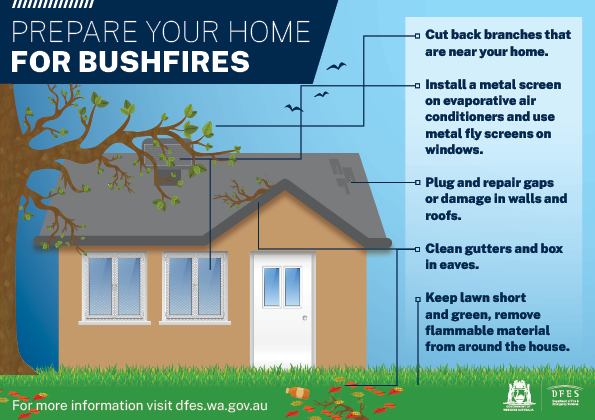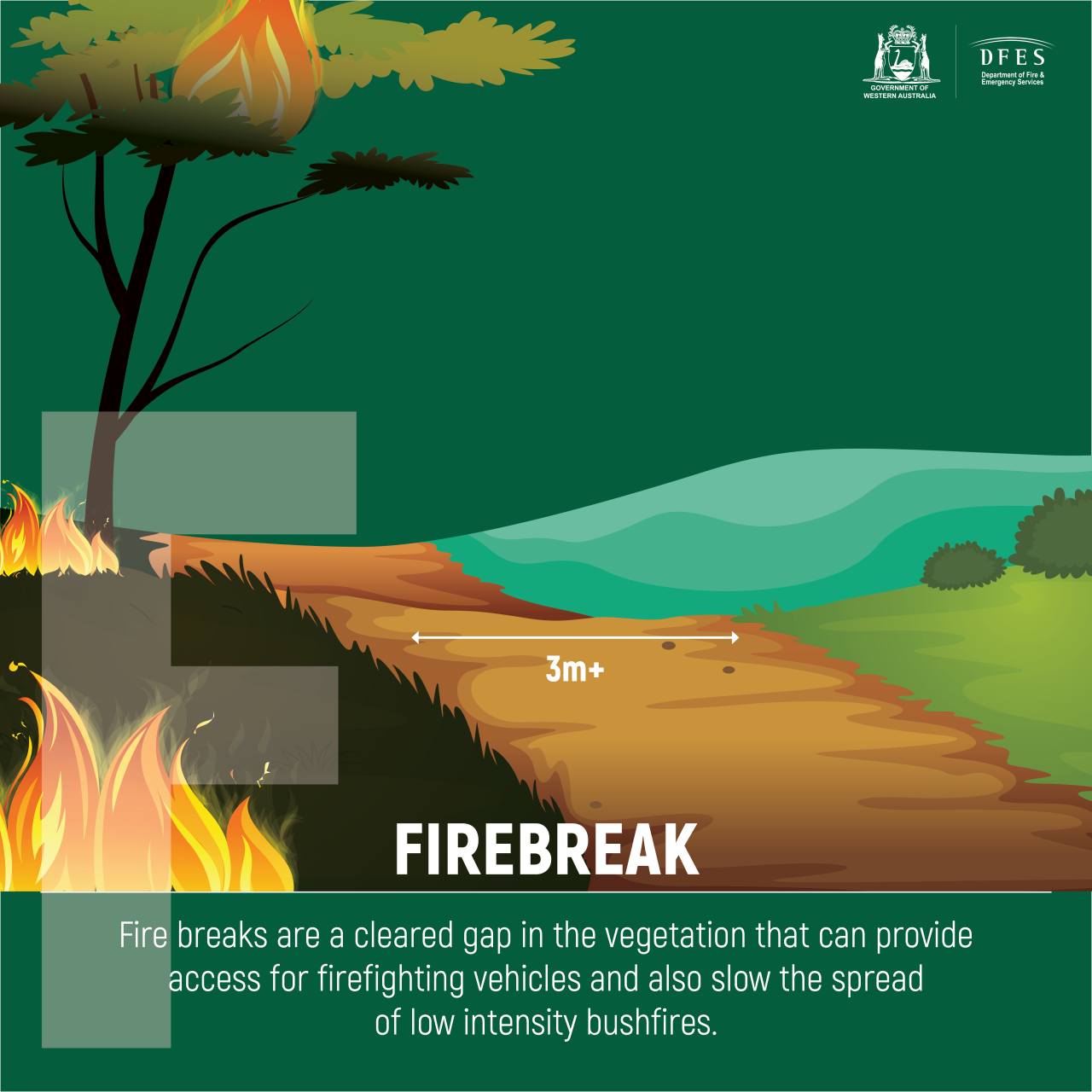Published on Thursday, 12 September 2024 at 1:05:30 PM
Shire of Pingelly Restricted Burning Period:
19 September 2024 – 31 October 2022
1 March 2025 – 29 March 2025
Shire of Pingelly Prohibited Burning Period:
1 November 2024 – 28 February 2025
Property Preparation for BUSHFIRES
It doesn’t matter if you’re staying or leaving, there are some important yet simple things you can do to help protect your home from fire.
Preparing Your Home for Bushfire Season: Essential Tips for Western Australia
As the bushfire season approaches, it's crucial to ensure your home and property are prepared to reduce the risk and impact of potential fires. In Western Australia, where bushfires can escalate rapidly due to our unique climate and vegetation, taking proactive steps is essential for safeguarding your family and property. The Department of Fire and Emergency Services (DFES) provides valuable guidelines to help you prepare. Here’s a comprehensive guide to getting your home ready for bushfire season:
- Create a Bushfire Plan
A well-thought-out bushfire plan is your first line of defence. Your plan should include:
- Evacuation Routes: Know how to get out of your area quickly and safely. Identify multiple routes in case one becomes blocked.
- Meeting Points: Designate a safe location where all family members will gather if you are separated.
- Emergency Contacts: Keep a list of important contacts, including local emergency services, and ensure everyone in your household knows how to reach them.
- Prepare Your Property
Reducing the fuel load around your property can significantly decrease the risk of fire spreading to your home. Follow these steps:
- Clear Vegetation: Remove any dry leaves, twigs, and branches from gutters, roof spaces, and around the base of your home.
- Maintain Gardens: Trim shrubs and trees, creating a minimum 2metre gap between your house and tree branches; and ensure there’s a defensible space of at least 20 metres around your home. Use fire-resistant plants and mulch. Keep the grass around the property to 10cm or less.
- Secure Flammable Materials: Store firewood, gas bottles, and other flammable materials away from your home, ideally in a shed or storage area that’s well away from the main building. Check gas bottle release valves face outwards away from the property.
- Firebreaks: Larger properties need to create firebreaks along all boundaries of their property suitable for fire truck access. Contact the shire to find out if your property is legally required to have a fire break.
- Check Your Home’s Defences
Ensure your home is equipped to handle a bushfire:
- Roof and Gutters: Install a metal gutter guard to prevent leaves and debris from accumulating. Ensure your roof is in good condition and repair any damage.
- Windows and Doors: Install metal fly wire mesh on all windows or vents. Fit external screens or shutters to protect against embers. Ensure all windows and doors are sealed properly to prevent drafts and embers from entering.
- Evaporative Air Conditioners: Install a protective screen on your evaporative air conditioner.
- Water Supply: Maintain a reliable water source for firefighting purposes. This could be a water tank or a connected hose that’s easily accessible.
- Emergency Kit and Supplies
Prepare an emergency kit that you can grab quickly if you need to evacuate:
- Essential Documents: Store important documents, including passports, insurance papers, and medical records, in a waterproof container.
- Food and Water: Keep a supply of non-perishable food and water for at least 72 hours.
- First Aid Kit: Include basic medical supplies and any prescription medications.
- Stay Informed
Stay updated with the latest information about bushfire risks and warnings:
- DFES Alerts: Regularly check the DFES website for the latest bushfire warnings and advice.
- Local Alerts: Sign up for local alert systems by contacting the shire and follow local news for updates on bushfire activity in your area.
- Community Involvement
Engage with your community to stay informed and prepared:
- Local Meetings: Attend community meetings or workshops on bushfire preparedness.
- Neighbourhood Watch: Join or form a neighbourhood watch group to ensure everyone in your area is prepared.
By taking these steps, you can enhance the safety of your home and protect your family during bushfire season. Remember, preparation is key to minimizing the impact of bushfires. For more information and detailed guidelines, visit the DFES Bushfire Preparation page and make sure you’re fully prepared for the season ahead.
Stay safe and be prepared!
PREPARE YOUR HOME AND PROPERTY FOR BUSHFIRES
Prior planning and property preparedness can also be vital in the event of a bushfire.
Visit Bushfire Overview - Department of Fire and Emergency Services (dfes.wa.gov.au) to learn more.
It is your responsibility to be prepared. Download, print and complete the Property Preparation Checklist to give your home and property the best possible chance of surviving a bushfire.
Prepare your home video: https://youtu.be/5yWlOegzwjk
Australian Warning System (AWS) - WA's new warning system for bushfire, cyclone, storm and flood.
Bushfire Plan – Bushfires happen every year. To survive a bushfire, you must be prepared to make your own decisions. The single biggest killer is indecision.
Download the Bushfire Preparation Toolkit here.
Fire Danger Ratings (FDR) describe the potential danger level you could face in a bushfire.
Click here for the Fire Danger Ratings fact sheet
For all current bushfire alerts and warnings visit emergency.wa.gov.au


Back to All News